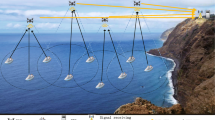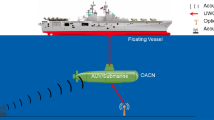Abstract
Since autonomous underwater vehicles (AUVs) are increasing popular in maritime applications, underwater wireless communication with multiple users is becoming more important and practical. In this paper, we investigate the resource allocation in underwater acoustic networks (UAN) with time division multiple access (TDMA) technique. When the uncertain channel state information (CSI) derived from the movement of AUVs in underwater environment is considered, probability constraints are introduced to guarantee the quality of service (QoS). A joint optimization algorithm is proposed, in order to schedule time for energy harvesting (EH) and wireless information transfer (WIT); the proposed algorithm also allocates transmit power to multiple AUVs to maximize the sum-throughput over a time period. The constraints of outage probability and available energy are both considered. The probability constraint is first transformed into an equivalent formulation. Furthermore, an approach with low computational complexity is proposed for power allocation and time assignment based on the residual energy of the buoy. In extensive simulation experiments, the proposed algorithm shows significant throughput increases in long term compared to baseline schemes, and better performance in terms of convergence and energy efficiency (EE) can be achieved.









Similar content being viewed by others
References
Al-Dharrab S, Uysal M, Duman TM (2013) Cooperative underwater acoustic communications. IEEE Commun Mag 51(7):146–153
Pompili D, Akyildiz If (2009) Overview of networking protocols for underwater wireless communications. IEEE Commun Mag 47(1):97–102
Lin C, Han G, Guizani M, Bi Y, Du J, Shu L (2020) An SDN architecture for AUV-based underwater wireless networks to enable cooperative underwater search. IEEE Wirel Commun 27(3):132–139
Li X, Zhu D (2018) An adaptive SOM neural network method for distributed formation control of a group of AUVs. IEEE Trans Ind Electron 65(10):8260–8270
Sahu BK, Subudhi B (2018) Flocking control of multiple AUVs based on fuzzy potential functions. IEEE Trans Fuzzy Syst 26(5):2539–2551
Ju H, Zhang R (2014) Throughput maximization in wireless powered communication networks. IEEE Trans Wirel Commun 13(1):418–428
Hadzi-Velkov Z, Nikoloska I, Karagiannidis GK, Duong TQ (2016) Wireless networks with energy harvesting and power transfer: joint power and time allocation. IEEE Signal Processing Letters 23 (1):50–54
Yang Z, Xu W, Pan Y, Pan C, Chen M (2018) Energy efficient resource allocation in machine-to-machine communications with multiple access and energy harvesting for IoT. IEEE Internet of Things Journal 5(1):229–245
Gautam S, Lagunas E, Chatzinotas S, Ottersten B (2019) Relay selection and resource allocation for SWIPT in multi-user OFDMA systems. IEEE Trans Wirel Commun 18(5):2493–2508
Wang S, Quan S, Liu X (2019) A novel power allocation scheme for multi-user single-DF-relay networks. Signal Process 159:13–19
Liu Y, Feng T, Peng M, Guan J, Wang Y (2021) DREAM: online control mechanisms for data aggregation error minimization in privacy-preserving crowdsensing. In: IEEE transactions on dependable and secure computing. https://doi.org/10.1109/TDSC.2020.3011679
Liu Y, Wang H, Peng M, Guan J, Wang Y (2021) An incentive mechanism for privacy-preserving crowdsensing via deep reinforcement learning. In: IEEE internet of things journal. https://doi.org/10.1109/JIOT.2020.3047105
Liu L, Ma M, Liu C, Shu Y (2017) Optimal relay node placement and flow allocation in underwater acoustic sensor networks. IEEE Trans Commun 65(5):2141–2152
Wang R, Yadav A, Makled EA, Dobre OA, Zhao R, Varshney PK (2020) Optimal power allocation for full-duplex underwater relay networks with energy harvesting: a reinforcement learning approach. IEEE Wireless Communications Letters 9(2):223–227
Zhou Y, Yang H, Hu Y, Kung S (2020) Cross-layer network lifetime maximization in underwater wireless sensor networks. IEEE Syst J 14(1):220–231
Xu J, Li K, Min G, Lin K, Qu W (2012) Energy-efficient tree-based multipath power control for underwater sensor networks. IEEE Transactions on Parallel and Distributed Systems 23(11):2107–2116
Jing L, He C, Huang J, Ding Z (2017) Energy management and power allocation for underwater acoustic sensor network. IEEE Sensors J 17(19):6451–6462
Zhang Y, Huang Y, Wan L, Zhou S, Shen X, Wang H (2016) Adaptive OFDMA with partial CSI for downlink underwater acoustic communications. Journal of Communications and Networks 18 (3):387–396
Song K, Ji B, Li C (2019) Resource allocation for relay-aided underwater acoustic sensor networks with energy harvesting. Physical Communications 33:241–248
Prasad G, Mishra D, Hossain A (2018) Joint optimal design for outage minimization in DF relay-assisted underwater acoustic networks. IEEE Commun Lett 22(8):1724–1727
Liu Z, Gao L, Liu Y, Guan X, Ma K, Wang Y (2020) Efficient QoS support for robust resource allocation in blockchain-based femtocell networks. In: IEEE transactions on industrial informatics, vol 16, pp 7070–7080
Stojanovic M, Preisig J (2009) Underwater acoustic communication channels: propagation models and statistical characterization. IEEE Commun Mag 47(1):84–89
Berkhovskikh L, Lysanov Y (1982) Fundamentals of ocean acoustics. New York, Springer
Coates R (1989) Underwater acoustic systems. Wiley, New York
Stojanovic M (2006) On the relationship between capacity and distance in an underwater acoustic communication channel. In: Proc. ACM int. workshop underwater netw. (WUWNet) , pp 41–47
Gong Z, Li C, Jiang F (2018) AUV-aided joint localization and time synchronization for underwater acoustic sensor networks. IEEE Signal Processing Letters 25(4):477–481
Kulkarni IS, Pompili D (2010) Task allocation for networked autonomous underwater vehicles in critical missions. IEEE Journal on Selected Areas in Communications 28(5):716–727
Liu Z, Xie Y, Yuan Y, Ma K, Chan KY, Guan X (2020) Robust power control for clustering-based vehicle-to-vehicle communication. IEEE Syst J 14(2):2557–2568
Xie Y, Liu Z, Chan KY, Guan X (2020) Energy-spectral efficiency optimization in vehicular communications: joint clustering and pricing-based robust power control approach. IEEE Trans Veh Technol 69(11):13673–13685
Acknowledgements
This work is partly supported by National Key R&D Program of China under grant 2018YFB1702100, National Natural Science Foundation of China under grant 61873223,61803328, and the Natural Science Foundation of Hebei Province under grant F2019203095.
Author information
Authors and Affiliations
Corresponding author
Additional information
Publisher’s note
Springer Nature remains neutral with regard to jurisdictional claims in published maps and institutional affiliations.
Appendix
Appendix
Proof of Theorem 1
We first assume that (x1, x2,...,xn) is the maximum of \(\sum \limits _{i=1}^{n}f_{i}(x_{i})\) while (19) is not satisfied, i.e. (29) holds.
When the constraint \(\sum\limits _{i=1}^{n}x_{i}=C\) is considered, \(x_{j}^{\prime }=x_{j}+\theta \) and \(x_{k}^{\prime }=x_{k}-\theta \) are assumed, where 𝜃 is a constant with tiny value and i≠j. We can obtain the following,
According to Eq. 30, it can be found that \(\ln (1+x_{j}^{\prime }/F_{j})+\ln (1+x_{k}^{\prime }/F_{k})\neq \ln (1+x_{j}/F_{j})+\ln (1+x_{k}/F_{k})\); hence the value of \(\sum\limits _{i=1}^{n}f_{i}(x_{i})\) can be changed by adding 𝜃 to xj. In other words, (x1, x2,⋯ ,xn) is not the optimum of \(\sum\limits _{i=1}^{n}f_{i}(x_{i})\) if Eq. 29 is true. Therefore, Theorem 1 is proved. □
Rights and permissions
About this article
Cite this article
Liu, Z., Meng, X., Yuan, Y. et al. Joint optimization for throughput maximization in underwater acoustic networks with energy harvesting. Peer-to-Peer Netw. Appl. 14, 2115–2126 (2021). https://doi.org/10.1007/s12083-021-01171-w
Received:
Accepted:
Published:
Issue Date:
DOI: https://doi.org/10.1007/s12083-021-01171-w




